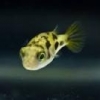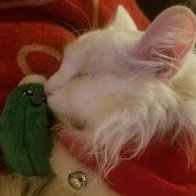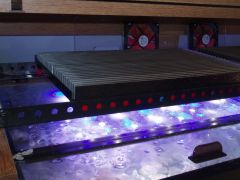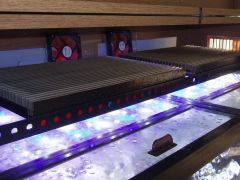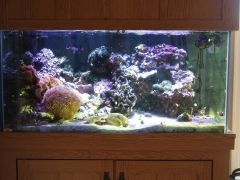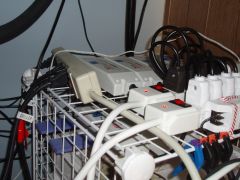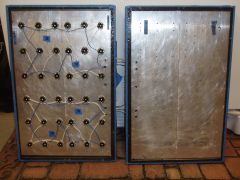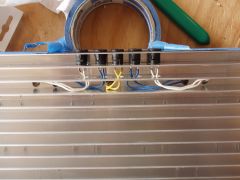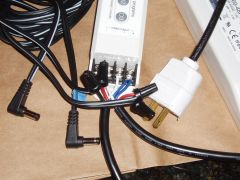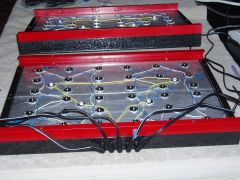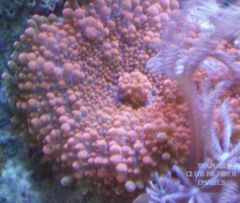
Reefn
BB Participant-
Posts
118 -
Joined
-
Last visited
Contact Methods
-
AIM
thompsonk
-
Website URL
http://
Custom Fields
-
Gender
Male
-
Location
Centreville
Recent Profile Visitors
Reefn's Achievements

Urchin (4/13)
-
I've gone YEARS without an aptasia problem. Suddenly a week ago I saw one poking it's ugly head above a rock. I ignored it for days and finally decided to look closer and found half a dozen clustered nearby. Aargh - not again. We've all had the problem and know these things are like roaches, if you see one, there are surely more. I ran through the traditional means of knocking them down, picked a method and started what I knew could easily become a tedious and never-ending job. I started wondering how I could make killing them fun - WHAT A CONCEPT! BORN this past weekend: Killing Aptasia - the DRINKING GAME. Equipment Needed: Small gauge hypodermic needle (Tractor supply if you don't already have) 2 Shot Glasses (or more if you're doing it with friends) Grain Alcohol (or other, but I wanted the highest octane available for this job) Rules: Fill at least 2 shot glasses with high octane hooch. Fill the hypodermic needle with hooch from one of the shot glasses. Inject the Aptasia with hooch. Celebrate the dying Aptasia by knocking back the other shot glass of hooch. ....Refill & Repeat as needed.... Seriously, the Aptasia WILL die quickly and you will enjoy the process. I sure did.
-
AlanM – Here’s what worked for me - Hydrogen Peroxide… And a Lot more than you think. Do a water change, hit hard, hit it soon and hit it again, then do another water change. Instructions – with revisions from experience: Day 1 Big water change (25%) to reduce the dinoflagellate population Lights Out, then Drugstore Hydrogen Peroxide (3%) @ 1ml/gal twice a day morning & evening (roughly 12hrs apart) Day 2 if it’s working, continue the dosing @ rate & frequency If it’s not beginning to work, bump the dose, Bump to 1.5ml/gal twice a day morning & evening (roughly 12hrs apart) Day 3 if it’s working, continue the dosing @ rate & frequency If it’s not working, bump the dose, This is the max dose I used - - 2ml/gal twice a day morning & evening (roughly 12hrs apart) Day 4 You should see nothing, or nearly nothing If it’s working, continue the dosing @ rate & frequency If it’s not working, bump the dose, I have not had to go past 2ml/gal twice a day morning & evening (roughly 12hrs apart) Day 5 Change the water again to get rid of toxins. Start the lights back up on a reduced cycle (maybe blue only for several days) and watch for recurrence of dinoflagellate – if I comes back even a little, start the H2O2 regimen again. The Story: Short Story - I fought this stuff for months several years ago and ended up losing two tanks – fish and coral. When I started both back up, I ended up with a recurrence of Dinoflagellate and some nuisance algae. I began the regimen listed above and the tanks did great. The fish, coral and inverts remain healthy as of this writing. Over the counter, drugstore 3% H2O2 is cheap and even cheaper at Costco. When all else failed, this worked. Longer Story - Generally, try 1ml to 2ml H2O2 per gallon for dino or algae problems. The worse the problem, the more you use. I started with 1ml/gal for three days with lights out and had some effect on the dino. It came back within a week. 1.5ml/gal was better, but still not enough effect over another three days... it came back. Then, the big gun… 2ml/gal over 4 days… kicked its cellular-arse. Some of you may be screaming – That 10-40 TIMES What you’ve read Elsewhere! That was my reaction when I went looking for just how high an H2O2 dosage I could try, and found ONE – Only ONE article that reported using up to 2ml/gal for algae removal, fish wounds and oxygenating water for transporting fish. I found only a couple of articles that went up to 1ml/gal specifically for dinoflagellates, bryopsis and other nuisance algae and for coral dips. So I decided to risk 1ml/gal for sure and ramp up to 2ml/gal if needed. I spent about 5 months trying to beat this the first time and lost nearly everything in 2 tanks (cross contamination from trying to save some corals) using the dosing levels you’ve all read about, .5ml to 1ml/10g. I wasn’t about to spend months fighting this again. Since I lost everything the first time – what did I have to lose… As soon as I saw the dino again, I decided it was time for some Darwinian level of action. I went looking for a better solution, found the one article mentioned above indicating potential safety at up to 2ml/gal and a couple others at 1ml/gal. I decided to jump on it hard. This well known Reco is for .5-1.0ml/10gal: http://www.reefcentral.com/forums/showthread.php?t=1955204 and elsewhere… Thread: Peroxide and the Kiss of Death (Dinoflagellates) This is what I used the first time. I cautiously ramped up to 4ml/10gal over the months of dark, light, dose, try again. All without any lasting effect - dino took over and killed all. Ultimately I used 35% H2O2 to decontaminate the tanks, which it did very well - you can believe that! This Reco is 1ml/1gal: https://o-r-c-a.org/forum/showthread.php?t=21735 Thread: Dosing Hydrogen Peroxide - The best kept secret for algae and dinos This was my floor this time around and there are a few more such references if you want to go looking. I only found 1 reference for using up to 2ml/gal (or 2ml/4L in the post) and it was the ticket that worked for me: http://www.aquariumadvice.com/forums/f24/hydrogen-peroxide-and-its-utility-130482.html Thread: Hydrogen Peroxide and Its Utility Once the 1ml/g didn’t kill every living thing in the tank, my confidence grew for 2ml/g as my ceiling. I did lose a lot of snails, but I think many were dying from the dino toxins first. I didn’t change the water before I started treating – I should have. Turned off the lights for 3-days, then used just blue for a week, then added low-white ramping up aver a week. If there’s a next time, I’ll do a massive water change, and then start H2O2 @ 1ml/gal and ramp quickly to 2ml/gal over 4 days. (1ml/g, 1.5ml/g, 2ml/g & 2ml/g, lights on to check for living dino, either enough or hit it again!) The snails that survived at the start of the treatment are still here and the amphipod population is still strong. H2O2 is my new best friend for Reef’n.
-
Nuisance algae ID and treatment recommendations please
Reefn replied to jason the filter freak's topic in General Discussion
Just tried to find a source for Aqua-Maid but was not successful. I did find a couple of references - one says it's 10%, another says it's 35% (but I think this later reference is actually AquaAid, a penetrating wetting agent for soil. I purchased Pure Health Discounts Hydrogen Peroxide 35%, 1 gal for $44.12 + $11.50 S/H from Amazon. The single gallon treated my 120g aquarium rock, sand and equipment - killed everything dead, dead, dead. My recent bout is probably from cross contamination with my 30g, which I did not nuke since I thought I had it under control last year. I recently moved two corals from the 30g to the 120g after several months of restart and noticed Dino again, first in 30g, then the 120g. That's when I started the 2ml/g regimen. -
Nuisance algae ID and treatment recommendations please
Reefn replied to jason the filter freak's topic in General Discussion
Jason – two words… Hydrogen Peroxide. …A Lot more than you think. Do a water change, hit hard, hit it soon and hit it again, then do another water change. I’ve just finished treating a recurrence of Dinoflagellate and nuisance algae. The tanks are doing great. The fish, coral and inverts are all well. I just did a big water change (30 gal/25% of my 120g) and still things are well several weeks later as of this writing. Over the counter, drugstore 3% H2O2 is cheap and even cheaper at Costco. When all else failed, this worked. Generally, try 1ml to 2ml H2O2 per gallon for dino or algae problems. The worse the problem, the more you use. I started with 1ml/gal for three days with lights out and had some effect on the dino. It came back within a week. 1.5ml/gal was better, but still not enough effect over another three days... it came back. Then, the big gun… 2ml/gal over 4 days… kicked its cellular-arse. Some of you may be screaming – That 10-40 TIMES What you’ve read Elsewhere! That was my reaction when I went looking for just how high an H2O2 dosage I could try, and found ONE – Only ONE article that reported using up to 2ml/gal for algae removal, fish wounds and oxygenating water for transporting fish. I found only a couple of articles that went up to 1ml/gal specifically for dinoflagellates, bryopsis and other nuisance algaes and for coral dips. So I decided to risk 1ml/gal for sure and ramp up to 2ml/gal if needed. I spent about 5 months trying to beat this in late 2015 into early 16 and lost nearly everything in 2 tanks (cross contamination from trying to save some corals) using the dosing levels you’ve all read about, .5ml to 1ml/10g. I wasn’t about to spend months fighting this again. Since I lost everything last time – what did I have to lose… As soon as I saw the dino again, I decided it was time for some Darwinian level of action. I went looking for a better solution, found the one article mentioned above indicating potential safety at up to 2ml/gal and a couple others at 1ml/gal. I decided to jump on it hard. This well reported Reco is for .5-1ml/10gal: http://www.reefcentral.com/forums/showthread.php?t=1955204 This is what I used in 2015. I cautiously ramped up to 4ml/10gal over the months of dark, light, dose, try again. All without any lasting effect - dino tookover and killed all. Ultimately 35% H2O2 did the job, you can believe that! This Reco is 1ml/1gal: http://www.o-r-c-a.org/forum/showthread.php?t=21735 This was my floor this time around and there are a few more references if you want to go looking. I only found 1 reference to using up to 2ml/gal (or 2ml/4L in the post) and it was the ticket that worked for me: Hydrogen Peroxide and Its Utility http://www.aquariumadvice.com/forums/f24/hydrogen-peroxide-and-its-utility-130482.html Once the 1ml/g didn’t kill every living thing in the tank, my confidence grew for 2ml/g as my ceiling. I did lose a lot of snails, but I think many were dying from the dino toxins first. I didn’t change the water before I started treating – I should have. Turned off the lights for 3-days, then used just blue for a week, then added low-white ramping up aver a week. If there’s a next time, I’ll do a massive water change, and then start H2O2 @ 1ml/gal and ramp quickly to 2ml/gal over 4 days. (1ml/g, 1.5ml/g, 2ml/g & 2ml/g, lights on to check for living dino, either enough or hit it again!) The snails that survived at the start of the treatment are still here and the amphipod population is still strong. H2O2 is my new best friend for reef’n. -
-
I used 8 Mean Well ELN-60-48P dimmable drivers from RapidLED for this 72 LED build. I used more power than needed just in case I wanted to add LEDs to any of the strings in the future. I also set the output of each driver to about 90% of recommended maximum power for each string - had to go buy a multimeter with a 10A setting to get that dialed in. This build has been running about a month now. At this point, there are only two things I plan to do differently. I'll probably add a bit more blue to each blue string - but wait until my 240 gal build to tinker with that - probably won't redo this on the 120 at all. Color looks like about equivelant to 12K on the 120 and I prefer about 14K-ish range when I ran Metal Halides. I could dial back the Cool Whites a bit but am in no hurry to do so. The only thing really left to do on the 120 gal build is to change out my wiring nut connection for 4-pin DIN plugs on each Driver, which I already ordered and received but haven't installed yet. That will clean up the installation a lot. The other thing I am likely to do differently is to change the direction of my wiring runs. Right now I have 2 strings of Cool White and 2 strings of Royal Blue on each unit and they all run front to back. For my next build, I think I'll wire the strings left to right so that I can control the lighting in layers from the front, middle and rear of the aquarium indepentantly. More light up front, a bit less in the middle, and even less in the rear. My recollection is that my PAR readings were about 1000 in the rear at the top of my rock to about 500 in the front sandbed. Lights are mounted within the canopy about 3" above the splash guard. On the 120 gal build--- Lights are running at about 80% in this picture. The shadowed sides are intentional to accommodate the shrooms. The light units sit on angle-iron - spaced & held in place with long bolts. Drivers and Dimmer: Here are a couple of pictures of the 30 gal unit: I intentionally started with 30 gal, then did the 120 gal - each of these builds has provided a lot of information and has guided what I will do with the 240 gal build. As stated earlier, only two changes likely for the 240 gal build - a bit more blue and side to side lintensity control. Installation though is likely to be quite different. Keith
-
I built 3 units so far - 5 more to go. 1x24 LED (all are 60 deg, dimmable plus 4 Moons) for my 30 gal 2x36 (20x60 deg and 52x40 deg, dimmable plus 8 Moons) for my 120 gal Fantastic PAR readings, great reliability, FAR less heat gain and I'm guessing my electric usage has dropped significantly too. The process is easy, the results are great. The hardest part was figuring out the right pieces to buy and from where. I settled on RapidLED for the Dimmable LED kits, Heatsink USA and a combination of Cables and Connectors, Minute-Man Electronics and Lowes for wiring and hardware. [Hoping I can post pictures] Here are the 120 gal units before installation: I still need 4 fixtures for my 240 gal plus 1 for the refugium and intend to build those too. Take the plunge - you'll love the challenge. Keith
-
DIY water warmer for RO/DI w/ cold input water
Reefn replied to BowieReefer84's topic in Do It Yourself
Geez - Really - 5 gal buckets? That's a pain. Get a 50+ gal barrel (I use 65gal food grade), put an auto shut off valve and a fried heater in it (plugged in for winter only) and let it run. Plenty of warm RODI water when I need it! Great for all my tanks! Best... -
Get the highest capacity you can afford and move on. I bought an RODI rated for 60gal/day. At my pressure, I'm getting about 30 gal's/day out of it - which is way more than my actual needs. Auto shut off - Coupled with a 65gal barrel - paid for itself in less than a year. I just pull water off as i need it and let it run. Good luck!
-
Been a member since I can't remember - never noticed that button!! Great link!
-
FWIW - I've purchased about $1,000 worth of coral from Mr. Coral over the past few years - never had a problem. Some in-store, some on-line. I'll use him again. Keith
-
I'll add kudos for ReefTopia -- great prices, prompt delivery - hard to beat!
-
-
Posted in Trading Forum: ========================== I have 7 food grade plastic barrels available - have stored water in them, now I have to make room in the garage. They're about 60 gals, were originally used to transport apple cider, I cleaned them out and have used them for water, also came in handy for load testing my large tank stand. I have one in service still for my RO/DI resevoir and will keep one other - the rest are to be pressed into service within this fine WAMAS community! Particularly interested in colorful SPS/LPS - Red, Pink, Teal, Neon, Orange, Yellow, Multi-colors -- Any interest? Make me an offer! Keith
-
I have an aussie acan - purchased from Mr. Coral at the WAMAS event there. I put it too close to the 400WMH and it rebelled. Didn't notice for days, and it lost a lot of tissue. Moved it to the bottom, and gradually moved it up to bottom third - exposed skeleton is now fully healed and new polyps are developing. Haven't done any direct feeding - so can't comment on that possibility, though it seems a quite reasonable explanation.



